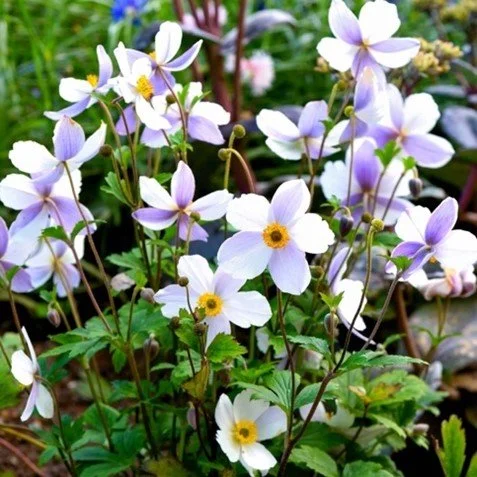Farrington Gurney: May 2024
We were so sorry to have to postpone the April Pollinator Party.
The driver of the Fixy van got Covid.
The repair people couldn’t make it.
And the cook doing the cookery demo was sick too!
BUT that just means our July 21st event will be even more action packed! So save the date for:

Fixy Van – confirmed!
Make Farrington Gurney village bunting: a huge collective effort
George Chan (ex-BBC natural history unit) on the connection between bio diversity and the climate crisis
Cookery demo and free lunch
A guided nature walk to Hollow March
Free quick clothes repairs
DIY bird feeders & bug boxes
…and at the end of the event, tea and scones will be available in the garden of the Manor House.
BULK PLANT PURCHASE SCHEME
You may recall that this was suggested at the February event and lots of people signed up for it.
The list of plants is below. Please email your order here no later than 19 May. Then the whole order will be priced and you will be contacted with the price for your order. 50% is payable before the order is placed and 50% on collection.
Anemone wild swan
Choisya ternate
Ceanothus thyrsiflorus repens
Cistus Silver Park
Nandina Firepower
Osmanthus burkwoodii
Pieris japonica
Philadelphus coronarius
Cornus alba elegantisima
Fuchsia Hawkshead
Geum Mai Tai
Lonicera periclymeneum
Parahebe catarractae
Syringa vulgaris
Salvia greggii
Skimmia japonica
Tamarix tetrandra
TO MOW OR NOT TO MOW?
It’s May, which to lots of people means a month when they are not just forgiven, they’re blessed, for not mowing. The argument is that giving the lawn a rest allows lawn flowers to bloom and feed pollinators. That’s important, because a loss in pollination means a loss in biodiversity. Many garden plants and agricultural/horticultural crops need pollinating insects to bring about pollination by transferring pollen from flowers’ anthers to the stigmas. This includes most fruit trees, soft fruit, and many runner beans, broad beans, tomatoes, marrows and courgettes.
The counter-argument is that not mowing the grass for just a month entices pollinators who feast for a month—only to get mowed down with the grass afterwards. If that’s the case, it’s far better to mow some parts of the garden as usual, while leaving other areas of the garden unmowed all through the spring and summer. If you can do that, everybody wins.
What the argument does highlight is that less mowing is better for pollinators. So indulge your inner laziness and find out: how much mowing could you not do this year?
GOING GREEN
Lots of families would like to be able to reduce their carbon emissions, but aren’t sure where to start. But a family in Australia sat down with their kids to make a plan to get to net zero by 2025. They broke the challenge into 4 areas : energy, food and waste, finance and travel. They started with the easy things they could do straight away, while making a plan for changes that need saving for – and the whole family got involved. Here’s a summary of the Hodgson Family Plan over time…
They say a big driver has been thinking of their kids’ futures—and getting them involved.
Here’s a quick summary of the changes they have been making:
Install solar panels
Compost all food waste
Buy carbon offsets to cover car emissions. Travel in one car where possible. Use public transport whenever possible.
Travel with bottles for water and/or coffee to reduce waste
Switch to a greener bank – one that doesn’t invest in fossil fuels. (Turned out, they saved money on their mortgage.)
Reduce energy use and buy offsets.
Reduce red meat consumption (tough for Australians but they did it!)
As they age and wear out, swap gas appliances for electric ones
Switch to green energy tariff
Buy battery to store energy from solar panels
Shop greener; avoid anything wrapped in plastic
Use public transport whenever possible
Save up for electric car in 2025.
The list isn’t perfect and not all of it is for everyone. (And the Australian climate is hardly the same as ours.) But it seems to have got them motivated – and talking about it has motivated their friends and neighbours too. Practice, not preaching.
So: what ideas have you put into practice that you’d like to share. Email here and we’ll do a summary next time.
GREEN NEWS FOR MAY
Not surprisingly, all of the Hodgson’s 4 categories are useful to Farrington Green too. Here’s what we’ve been up to:
ENERGY: The Village Hall got an energy survey last week, a first step (we hope) towards getting solar panels on the Hall roof. As the biggest building in the village, putting panels on it would make a huge difference to our carbon footprint. The Hall committee has been very active fundraising for this; to date they’ve raised more than £7K so, if you can, please keep up the momentum. We’re getting there!
FOOD AND WASTE: We have an agreed site for the Community Fridge, which will be placed on the right as you walk or drive into Farrington’s farm shop site. Thanks to Andy and Tish for being enthusiastic supporters. We have also received a grant from BANES for £500 which should go towards buying the fridge. The next step is getting the shed for the fridge built. If you are a carpenter or electrician who can help, please contact us here.
Ross Perkins has been leading this project—with massive, friendly help from the fridge team at Shepton Mallet – and he has a good list of people who have volunteered to help run the fridge. They’ll all be contacted once it’s installed.
It’s worth remembering: Community Fridges are NOT food banks. They are for everyone to put food into (going away for the weekend and have bread and veg you won’t eat?) or take food out of. Tesco and the Coop will also be contributing food.
TRAVEL: In all the discussions about the Local Plan for the village, the parish council will be collecting data and making strong arguments about the need for a greatly improved bus to Bath (that doesn’t take forever and actually turns up) and a cycle path. This can also have a great impact on air quality, if BANES gets it right. If you know of anyone with professional expertise in this area, please send them our way. To have an impact on planning decisions requires hard evidence that can withstand legal challenge, so we need expertise!
FINANCE: Farrington Green is run by volunteers, so we have no loans or investments. Our biggest asset is your support.
BIODIVERSITY
The Hodgson family seems to have overlooked completely the biodiversity loss caused by climate change. But Farrington Greeners have not! Thanks to Sara Price, our village is now enrolled in the Royal Horticultural Society’s SouthWest in Bloom scheme. Sara writes:
' Some of you may remember a lively talk given about the Royal Horticultural Society. We had thought of starting small with one site but the RHS’s Sean Fletcher was so impressed by our village that he encouraged us to make applications to develop four sites in the village!
These are:
The Farrington Gurney sign next to the allotments
The Green holding our miner, on the corner of Paulton Road
The large green area outside the farm
The green area on Main Street (site of the post box).
Our applications have been accepted and “judging” will take place on the 1st of July—no medals or rosettes but some friendly and constructive advice to move things along. The idea is that next year they will be able to assess the difference we've made.
Now starts the work in transforming these sites. The intention is to make them pollinator friendly with as much local/ native flora as possible. We understand that ‘native’ means that it’s been in the Uk for the past 200 years. Those of you who know these sites well will know that some poetic license will be required.
Work will soon begin and we need willing hands from young and old. Please let us know HERE [there will be a link to email] if you can help.
And if you are passing, stop and ask us what we are doing and what the plan is. We will do our best to keep the sites tidy and beautiful but we need your help.’









